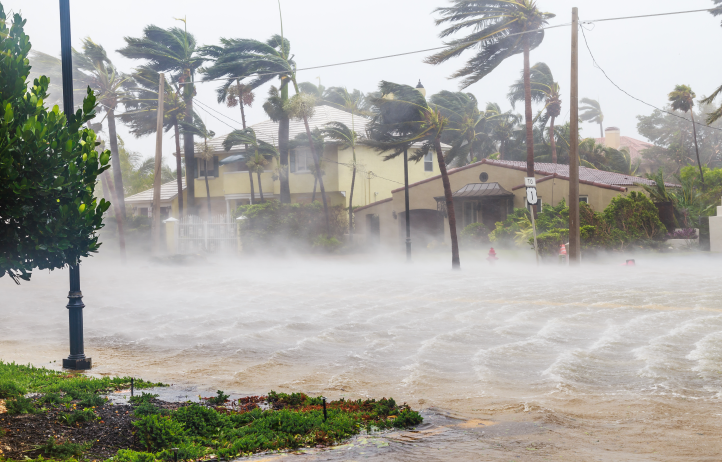THE TIME TO GET READY IS NOW
According to the National Oceanic and Atmospheric Administration (NOAA), the official Atlantic hurricane season begins on June 1 and runs through the end of November with most activity taking place between mid-August and mid-October. The eastern Pacific hurricane season lasts from May 15 through November 30. Although stating dates like these can give the feeling that hurricane season is an expected, routine occurrence – and it is – it can belie the fact that the intensity and impact of any given storm will not truly be known until it makes landfall. As of this writing, Hurricane Idalia is currently strengthening as it heads toward Florida, likely bringing great concern to residents who have been through this before.
Hurricane Ian was a massive Category 4 Atlantic storm that struck Florida’s southwestern coast on September 28, 2022. Areas near Fort Myers Beach and Sanibel Island were left in ruins after experiencing historic rainfall, flooding, and winds that topped 150 mph as the storm stalled out over the region. Homes in Lee County that were up to 3 miles from the Gulf of Mexico were impacted by an intense storm surge and many homes and businesses were destroyed. Hurricane Ian left between $50 billion to $65 billion in insured damages, which is the second-largest insured loss on record after Hurricane Katrina in 2005.
While modern technology has allowed better understanding of when a storm is coming and where it is forecast to go, that simply gives more time to physically prepare, especially if the weather event is unusual. Tropical storm Hilary made history in August when it was the first tropical storm to hit Los Angeles in 84 years. Beginning as a hurricane off Mexico’s Pacific coast, it was a surprise to homeowners and scientists alike when they learned it was actually coming. As it continued its path inland, it brought record rainfall and flooding to desert areas not normally associated with wet weather, and some were impacted by high wind gusts, flash floods and landslides. Death Valley National Park had to be closed and received a year’s worth of rain in just one day. New state records for tropical cyclone rainfall were established in Nevada, Oregon, Idaho, and Montana. AccuWeather estimates that Hilary caused $7 billion to $9 billion in damage and economic loss.
Whether a storm is typical or surprising for an area, they all hold in common the potential of inflicting tremendous damage. The lesson we can learn from these past events is that the time to financially prepare for a weather disaster is well before it arrives.
Do you have adequate insurance? Depending on where you live, and whether you own or rent, different levels of coverage may be appropriate. Insurance policies are highly customizable and should be reviewed with a knowledgeable agent to make sure you are suitably covered.
Types of Insurance to Consider
- Homeowners Insurance – Most single-family homeowners insurance policies are HO-3s, otherwise known as special form policies. Mortgage lenders are likely to require that you carry enough homeowners insurance to pay for a “complete rebuild of your home in the event of a fire, storm, or other covered damage.” Some lenders only require coverage equal to the unpaid amount of your mortgage balance, but if you are underinsured, you could be left with significant out-of-pocket costs to repair or rebuild. If you own your home outright, you are not legally required to have an insurance policy, but you would be vulnerable in the event of a disaster or lawsuit.
Homeowners policies can cover the dwelling at its replacement cost and your personal property at its actual cash value, but it’s important to understand what is and is not covered under the specifics of your policy. For instance, damage from mold, fungus, wet rot, or flooding may be considered “excluded perils,” yet, all of these could impact your home as result of a storm surge, as was seen in both Hurricane Ian and Superstorm Sandy. Additional living expenses (ALE) coverage is generally included in homeowners insurance and can offset temporary living expenses if a weather event, that is a covered clause in your policy, forces you to leave under mandatory evacuation order, or renders your home unlivable due to damage from a covered peril.
- Renters Insurance – While renters insurance policies do not specifically cover hurricanes, renters can be reimbursed for personal property that is damaged by a covered peril. Lighting, wind damage, hail, fire, burst pipes, and falling objects like trees, all of which can be caused by a hurricane, are generally covered. Similar to homeowners insurance, flood damage is typically not covered, and regionally, some renters insurance may exclude wind damage. However, loss-of-use coverage in a renters policy can provide for hotel bills and meals should your rental sustain severe enough damage (from a covered peril) that your home is uninhabitable.
- Flood and Earthquake Insurance – Floodwaters can cause some of the worst damage to homes and property, yet coverage for flooding is typically not included in homeowners or renters insurance. A separate flood insurance policy can cover a building or its contents, or both. Homes and businesses in high-risk flood zones with mortgages from government-backed lenders are required to have flood insurance, but 1 in 4 flood claims come from homeowners who are not in those areas. Even non-coastal locations can experience flooding due to construction, poor drainage, or proximity to rivers or other bodies of water, so it can be a good idea to consult with your insurance agent to see if it might be worthwhile to purchase flood insurance for your property. The National Flood Insurance Program (NFIP) is managed by the Federal Emergency Management Agency (FEMA). FEMA also states that those who live in earthquake-prone locations may be able to purchase earthquake insurance, as standard homeowners insurance does not cover damage resulting from land movement or landslides.
Other Tips to Prepare for a Storm
- Build a well-funded emergency account. A savings account with three to six months’ worth of essential living expenses can help you through the weeks and months after a storm.
- Take pictures or video before and after the storm. Photos or a quick walkthrough video can help you prove condition of your home and inventory belongings before any possible damage occurs. If you do need to file a claim after the storm, document damage as clearly as possible.
- Make sure you have your insurance agent’s contact information added to your phone. It’s also helpful to have a copy of your policy with you should you need to leave your home. Keep notes regarding any communication you have with your insurance company indicating who you spoke with and when.
- Have a “go bag” ready. In case you need to evacuate, make sure each family member has a bag prepared with three days of supplies. Bring photo identification, any necessary medication, essential personal items, non-perishable food and water, a first-aid kit, flashlight, phone charger, hand sanitizer, batteries and a battery-powered or hand-crank AM/FM radio. Be sure to have some cash on hand as power outages may interfere with electronic payment methods and ATMs.
- Essential Documents. Originals should be stored safely in a fireproof/waterproof safe or bank safe deposit box. Have copies of documents including passports, social security cards, Medicare cards, birth and marriage certificates, title documents, etc., in a waterproof, zip bag that you can bring with you and access if necessary.
- Keep receipts. Your insurance policy may reimburse you for a variety of expenses you incur if you are unable to remain in your home due to a storm.
- Speak with a professional. A good insurance agent can review your needs and help you obtain the most suitable policies for your specific situation.
If you would like more information about how adequate insurance can be part of a healthy financial plan, please contact us.


